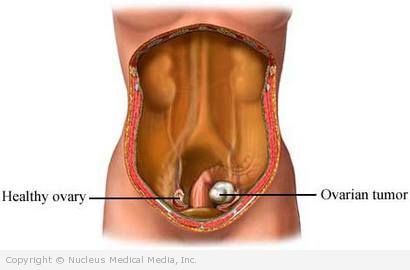(Cancer of the Ovaries; Cancer, Ovarian)
Ovarian cancer – Definition
Ovarian cancer is the growth of cancer cells in the ovaries. The ovaries make eggs for reproduction and female hormones. The most common type of ovarian cancer is epithelial.
Cancer occurs when cells in the body divide without control or order. If cells keep dividing uncontrollably, a mass of tissue forms. This is called a growth or tumor. The term cancer refers to malignant tumors. They can invade nearby tissue and spread to other parts of the body.
Many of these tumors may grow to be very large without showing symptoms. These tumors can be hard to find during a physical exam. As a result, about 70% of patients are found with advanced disease.
Germ cell tumors come from the reproductive tissue. They account for 20% of tumors. Stromal cancers are more rare. These come from the connective cells of the ovary. They typically make hormones that cause symptoms.
Ovarian cancer – Causes
The causes of ovarian cancer are not known. However, research shows that certain risk factors are associated with the disease.
Ovarian cancer – Risk Factors
Factors that increase your chance for ovarian cancer include:
- Family history of ovarian cancer, especially in mother, sister, or daughter
- Age: 50 or older
- Menstrual history — first period before age 12, no childbirth or first childbirth after age 30, and late menopause
- Personal history of breast cancer or endometrial cancer
- Certain gene mutations, including BRCA1, BRCA2
Use of birth control pills for more than five years appears to decrease risk.
Ovarian cancer – Symptoms
Symptoms often only appear in the later stages.
Symptoms include:
- Abdominal discomfort and/or pain
- Gas, indigestion, pressure, swelling, bloating, or cramps
- Ascites
- Nausea, diarrhea, constipation, or frequent urination
- Loss of appetite
- Feeling of fullness even after only a light meal
- Unexplained weight gain or loss
- Abnormal bleeding from the vagina
- Hair growth, voice deepening, acne, loss of menstrual periods in some rare stromal tumors
These may also be caused by other, less serious health conditions. Anyone with these symptoms should see a doctor.
Ovarian cancer – Diagnosis
Your doctor will ask you about your symptoms and medical history. A physical exam will be done.
Tests may include:
Pelvic Exam
Your doctor will use her gloved finger to check your:
- Uterus
- Vagina
- Ovaries
- Fallopian tubes
- Bladder
- Rectum
She will check for lumps or a change in size or shape.
Diagnostic Tests
Your doctor will use a combination of tests to help diagnose your condition:
- Ultrasound — a test that uses sound waves to examine the body
- Biopsy of tissue or cells
- Computed tomography (CT) scan — a type of x-ray that uses a computer to make pictures of structures inside the body
- Magnetic resonance imaging (MRI) scan — a test that uses magnetic waves to make pictures of structures inside the body
- Lower gastrointestinal (GI) series or barium enema — injection of fluid into the rectum that makes the colon show up on an x-ray so the doctor can see abnormal spots
- CA-125 assay — a blood test to measure the level of CA-125, a substance in the blood that may be elevated if ovarian cancer is present
- OVA1 test — a blood test done after a pelvic mass is found; certain protein levels in the blood can indicate whether a pelvic mass is cancerous
Other tests may also be done to analyze the blood.
Ovarian cancer – Treatment
Treatment depends on the extent of the cancer and your general health.
General Approach
If ovarian cancer is found, staging tests are done. They will help to find out if the cancer has spread and, if so, to what extent.
The more advanced the tumor, the poorer the prognosis. About, 75% of all epithelial tumors are in an advanced when they are found. The overall five-year survival rate is about 50%.
Surgery is often the first step. Afterwards, you will receive chemotherapy. Sometimes, radiation therapy of the abdomen is given.
Treatments include:
Surgery
The cancerous tumor and nearby tissue will be removed. Nearby lymph nodes may also be removed.
Chemotherapy
Chemotherapy is the use of drugs to kill cancer cells. It may be given in many forms including pill, injection, and via a catheter. The drugs enter the bloodstream. They travel through the body killing mostly cancer cells. Some healthy cells are killed as well.
Radiation Therapy (Radiotherapy)
This therapy uses radiation to kill cancer cells and shrink tumors. Radiation may be:
- External radiation therapy — radiation directed at the abdomen from a source outside the body
- Intra-abdominal P32 — sometimes a radioactive solution may be introduced into the abdomen as part of treatment
The more advanced the tumor at diagnosis, the poorer the prognosis. Unfortunately, 75% of all epithelial tumors are stage 3 or 4 at the time of diagnosis. The overall five-year survival rate is about 50%.
Ovarian cancer – Prevention
There are no guidelines for preventing ovarian cancer because the cause is unknown. Symptoms also are not present in the early stages. If you think you are at risk for ovarian cancer, talk to your doctor. Schedule check-ups with your doctor if needed. All women should have regular physical exams. These should include vaginal exams and palpation of the ovaries.

